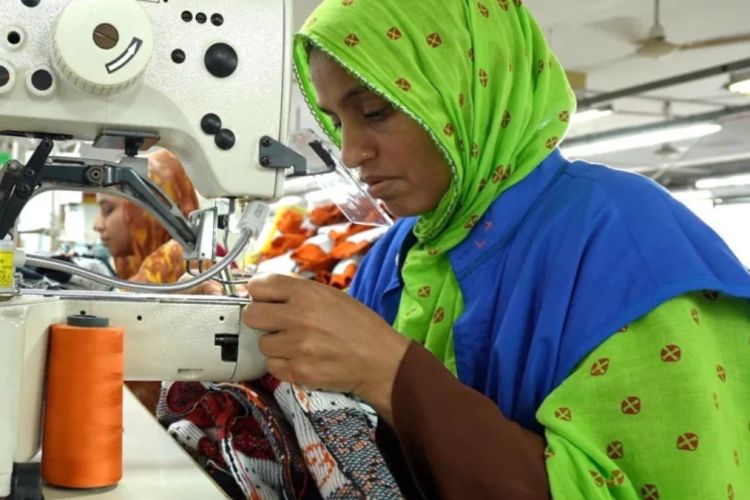
Bangladesh plays a significant role in the global garment industry. The growth of its ready-made garments sector enabled the country to achieve lower-middle-income status in 2015. However, the ongoing political turmoil has affected the economy. Informal workers, who account for 85% of the country’s workforce, are particularly vulnerable to the crisis. Dhaka’s real gross domestic product (GDP) growth slowed to 4.8%, and the current account deficit stood at 0.8% of the GDP in 2024. It is expected to decline further to 2.7% in 2025, as projected by the IMF’s World Economic Outlook.
The textile industry, which contributes 80% of Dhaka’s exports and 15% of its GDP, remains a crucial sector of the economy. The country primarily exports textiles to markets such as the European Union, the United States, Canada, Australia, and Japan.
READ | PMAY-U 2.0: Govt must focus on sustainable all-weather homes
Textile industry takes a hit
Bangladesh’s apparel sector is grappling with multiple challenges, including political unrest, labour disruptions, and the aftermath of natural disasters like floods. The violent protests that led to the resignation of Prime Minister Sheikh Hasina have crippled factory operations, leading to substantial financial losses to the tune of $800 million (Tk 6,400 crore). Adding to these challenges is Dhaka’s upcoming graduation from least developed country (LDC) status which will result in the loss of preferential trade privileges, making its apparel products more expensive in key markets like the EU and the US.
Dhaka is a critical market for Indian textiles, and current concerns in the country are raising significant issues for India’s textile and apparel sector. The nation serves as both a manufacturing hub and an important export destination for India, with annual Indian cotton exports to Dhaka amounting to $2.4 billion. According to data from the Ministry of Commerce, the country’s share in India’s total cotton exports surged from 16.8% in FY13 to 34.9% in FY24.
The trade relationship between New Delhi and Dhaka spans various sectors, including trade, medical tourism, and corporate expansion. India exports a wide range of products to Bangladesh, including agriculture, textiles, machinery, electronics, auto parts, and refined petroleum, while importing fish, plastics, leather, and apparel. Notably, textiles, garments, and made-ups make up 56% of Indian imports from Bangladesh, benefiting from zero tariffs under the South Asian Free Trade Area agreement. In FY 2023-24, India’s exports to Bangladesh fell to $11 billion, down from $12.21 billion in 2022-23.
The Indian textile industry is one of the largest globally, contributing 4-5% of global trade in textiles and apparel. The US, with apparel revenue of $351.35 billion, and China, with $313.82 billion, lead the global market, with India ranked behind these two giants. The apparel market accounts for 1.63% of the global GDP and is projected to grow at a CAGR of 2.81% between 2024 and 2028.
In India, the textile sector contributes 2.3% to the national GDP, 12% to exports, and 13% to industrial production. Bangladesh is a key partner for India’s textile industry, and any disruption in Bangladesh’s supply chain could immediately affect India’s production flow, potentially leading to market delays and shortages. Such disruptions force companies to seek alternative sources, affecting the availability of products globally.
Bangladesh’s recent political unrest presents both risks and opportunities for India. As a neighboring country with a robust textile sector, India must strategically position itself to benefit from this crisis while ensuring its textile industry remains competitive and resilient. India’s textile hubs, such as Tirupur, could gain as global brands, wary of Bangladesh’s instability, look to diversify their supply chains. Indian manufacturers can step in to fill gaps left by Bangladesh, particularly for time-sensitive shipments, as Bangladesh’s logistical bottlenecks have forced companies to rely on expensive air freight.
How India can benefit
Strengthening Domestic Capacity: India should capitalise on its established textile hubs by increasing production capacity and improving logistics. Strategic investment in technology and infrastructure, particularly in hubs like Tirupur, could further solidify India’s global textile leadership.
Policy Support for Exporters: The Indian government could offer fiscal incentives, subsidies, and streamlined export policies to help Indian exporters respond quickly to shifting global demand. This might include reducing tariffs on raw materials, expediting export processing zones, and providing tax relief to expanding textile firms.
Diversifying Product Range and Markets: India should explore expanding its apparel offerings, including sustainable textiles, organic cotton, and eco-friendly manufacturing, to attract brands seeking ethically produced goods.
Collaborating with Foreign Investors: Bangladesh’s political instability is prompting foreign investors to seek alternatives in South Asia. India could encourage joint ventures and foreign direct investment (FDI) in its apparel industry, leveraging this opportunity to enhance technological capabilities and secure long-term investments.
Building a Skilled Workforce: Automation poses a challenge to job creation in both Bangladesh and India. Prioritising workforce upskilling in modern manufacturing processes will help India attract global brands looking for efficient labour solutions.
While Bangladesh’s apparel industry is undergoing a turbulent period, India has an opportunity to step in and fill the gap in the global supply chain. Through strategic investments, policy support, and a focus on diversifying its apparel products, India can strengthen its textile industry and position itself as a stable and reliable alternative for global brands. The future of South Asia’s textile dominance may depend on how quickly and effectively India can adapt to the evolving global apparel landscape.
Bhanu Suri is PGP student, IIM Shillong
Naliniprava Tripathy is an Indian economist based in Shillong. She teaches finance at IIM Shillong.

